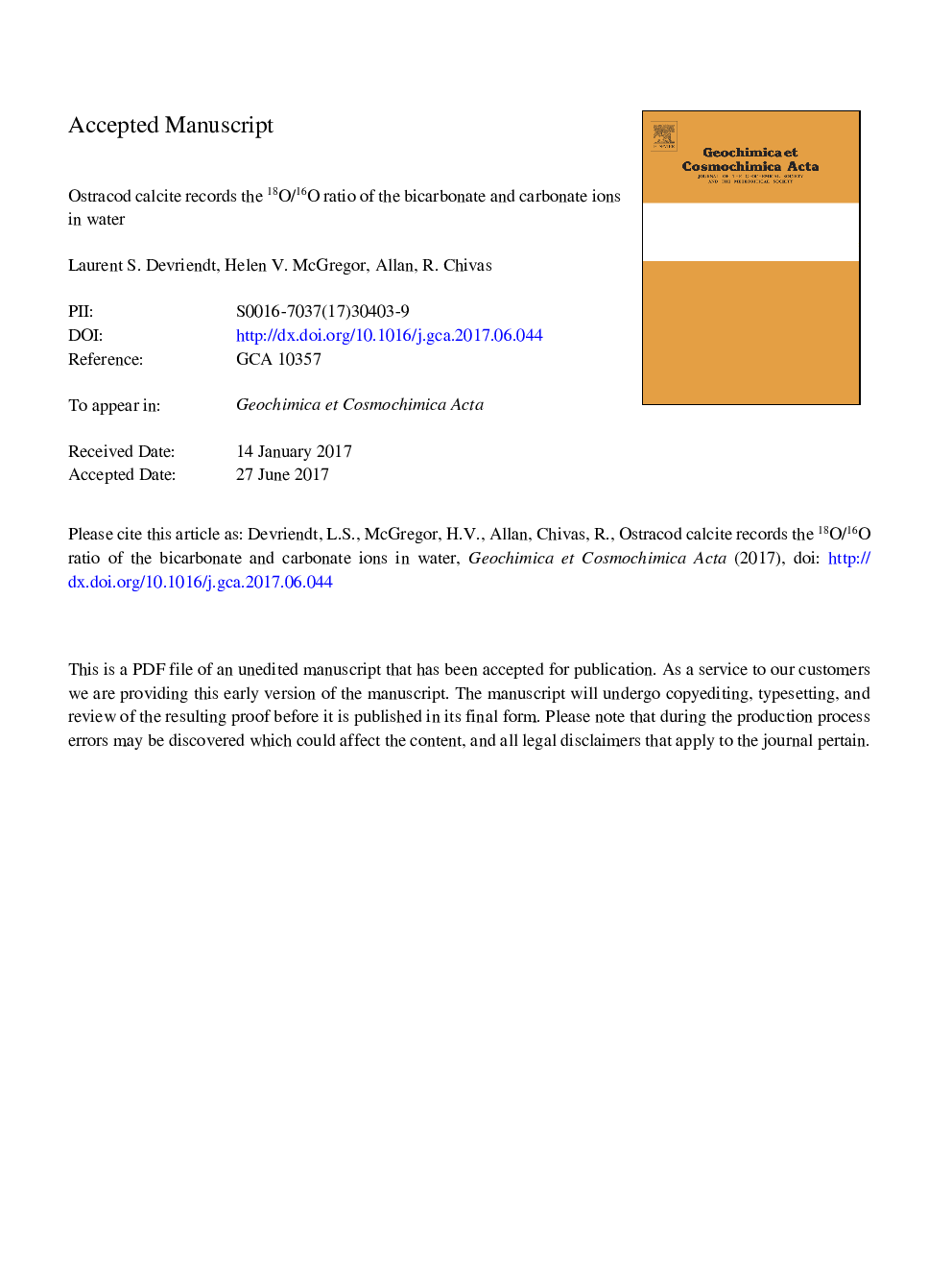| کد مقاله | کد نشریه | سال انتشار | مقاله انگلیسی | نسخه تمام متن |
|---|---|---|---|---|
| 5783134 | 1637943 | 2017 | 44 صفحه PDF | دانلود رایگان |
عنوان انگلیسی مقاله ISI
Ostracod calcite records the 18O/16O ratio of the bicarbonate and carbonate ions in water
دانلود مقاله + سفارش ترجمه
دانلود مقاله ISI انگلیسی
رایگان برای ایرانیان
کلمات کلیدی
موضوعات مرتبط
مهندسی و علوم پایه
علوم زمین و سیارات
ژئوشیمی و پترولوژی
پیش نمایش صفحه اول مقاله

چکیده انگلیسی
The δ18O of ostracod valves is widely used to infer water δ18O and temperature. However, ostracod δ18O appears sensitive to other environmental variables. In addition, there is species-dependent ostracod calcite 18O enrichment, relative to slowly precipitated inorganic calcite under the same conditions. Together these uncertainties complicate ostracod paleoclimate reconstructions. This study presents a new understanding of the causes of ostracod δ18O variations based on a global database of published ostracod δ18O values in lake, marine and coastal environments, and from culture experiments. The database includes associated field/experiment host water parameters including temperature (â1 to 32 °C), water δ18O (â13.2â° to 4.3â° VSMOW), pH (6.9-10.4), salinity (0-72 g/kg), calcite saturation states (0.6-26), and dissolved inorganic carbon concentration [DIC] (0.9-54.3 mmol/kg). The data show that: (1) the δ18O of marine and non-marine ostracods reflects the 18O/16O of the sum of host water CO32â and HCO3â ions. For example, at a given temperature, the δ18O of non-marine ostracods decreases by 4â° to 6â° as [CO32â]/[DIC] reaches 70%, depending on the ostracod species. In low [CO32â]/[DIC] settings (i.e. high HCO3â/CO32â), ostracod 18O/16O is close to the 18O/16O of HCO3â ions, which explains why on average ostracod δ18O is higher than the δ18O of inorganic calcite precipitated slowly under the same conditions. (2) Taxonomic offsets in ostracod δ18O vary with the host water [CO32â]/[DIC]. In environments where HCO3â â«Â CO32â (i.e. most freshwater lakes), the 18O/16O of Candonids is indistinguishable from the 18O/16O of HCO3â ions (difference of 0.10 ± 0.16â°) while the 18O/16O of Cyprids is lower than the 18O/16O of HCO3â ions by â0.77â° to â0.32â°, Cytherids by â0.88 ± 0.29â°, and Limnocytherids by â1.12 ± 0.05â°. (3) The sensitivity of ostracod δ18O to [CO32â]/[DIC] also varies with taxonomy. For each percent increase in [CO32â]/[DIC], Candonids δ18O decreases by â0.098 ± 0.024â°, Cyprids by â0.075 ± 0.004â°, Cytherids by â0.057 ± 0.012â°, and Limnocytherids by â0.058 ± 0.005â°. (4) The similarity in 18O/16O between ostracod calcite and the sum of host water 'HCO3â and CO32â' (despite species-specific offsets) suggests rapid precipitation of a finite DIC pool in the ostracod calcifying fluid. We propose an ostracod δ18O model whereby the more negative the 18O/16O of a given species relative to the sum of CO32â and HCO3â, the greater the isotopic equilibrium between the DIC pool and H2O in the ostracod calcifying fluid. (5) Higher host water salinities and pH induce higher [CO32â]/[DIC], resulting in lower ostracod δ18O, which explains the variable salinity and pH effects on ostracod δ18O. Our database and ostracod δ18O model shows that ostracod δ18O records from closed basin environments likely reflect high or variable [CO32â]/[DIC], rather than water temperature and δ18O alone. Our study reconciles contradictory observations of controls on ostracod δ18O and paves the way for improved paleo-environmental interpretations and reconstructions of past water [CO32â]/[DIC].
ناشر
Database: Elsevier - ScienceDirect (ساینس دایرکت)
Journal: Geochimica et Cosmochimica Acta - Volume 214, 1 October 2017, Pages 30-50
Journal: Geochimica et Cosmochimica Acta - Volume 214, 1 October 2017, Pages 30-50
نویسندگان
Laurent S. Devriendt, Helen V. McGregor, Allan R. Chivas,